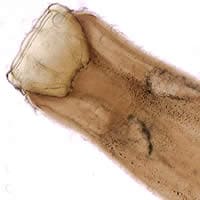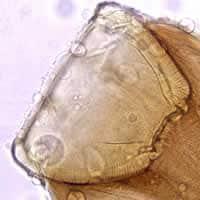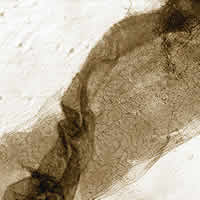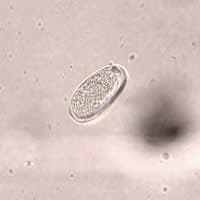
Monthy Case Studies - 2002
Case #78 - February, 2002
A 60-year-old woman with an extensive travel history to various Caribbean Islands, consulted an infectious disease specialist because of a persistent cough she had been experiencing for a few weeks. Visual examination of the patient's throat revealed what appeared to be a worm or worms attached to the mucosa. The objects were removed with forceps, mounted on glass slides (whole, not sectioned), and forwarded to the Florida Department of Health for identification. The slides were subsequently forwarded to CDC for a consult. The objects were in pieces and measured approximately 0.5 to 1 cm in length; other egg-like objects measured 70 to 80 micrometers in length. Figures B, C, and D were captured using differential interference contrast microscopy to visually enhance diagnostic features. What is your diagnosis? Based on what criteria?

Figure A

Figure B

Figure C

Figure D

Figure E
Answer to Case #78
This was a case of syngamiasis caused by a species of Mammomonogamus (formally known as Syngamus laryngeus), a common parasite of the respiratory tract of ruminants in the tropics. Very few cases of human infection with this parasite have been reported to date. The worms typically attach to the mucosa of the throat or trachea causing a chronic cough. The adult female can reach a length of about 2 cm and the eggs range from 75 to 100 micrometers, depending on the species. Another unique aspect of this species is that the smaller male worm is attached in permanent copula to the female. Although earthworms serve as intermediate hosts for the species infecting birds, the life cycle of the mammalian species has not been elucidated. This case was provided by the Florida Department of Health and is used by DPDx with permission. Diagnostic features shown in the images included:
- a large buccal capsule directed anteriorly, in contrast to the hookworms in which the buccal capsule is turned laterally.
- the absence of teeth or cutting plates, which would be diagnostic of hookworm infection.
Images presented in the monthly case studies are from specimens submitted for diagnosis or archiving. On rare occasions, clinical histories given may be partly fictitious.
 ShareCompartir
ShareCompartir


